- info@wildlife-removal.com
Call us for help in your town
Wildlife Removal Education
Opossum in the Attic
Need opossum removal in your hometown? We service over 500 USA locations! Click here to hire us in your town and check prices - updated for year 2020.
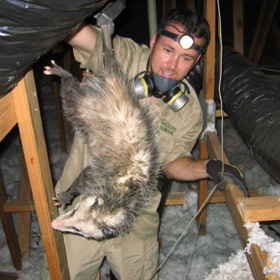 Opossums are usually classified as a pest species due to their habits of scavenging and living in attics and under houses. When possums live in the attic, they cause the following problems:
Opossums are usually classified as a pest species due to their habits of scavenging and living in attics and under houses. When possums live in the attic, they cause the following problems:
- Noise while crawling around in the attic
- Large droppings throughout the attic
- Spread of pathogens and parasites in house
- Baby opossums fall down walls from attic
- Adult or baby possums die in attic and cause huge odor
- Opossums cause damage to ducts and insulation in attic
Many people don't believe me when I say that I remove opossums from attics. Well, I do, and I remove a LOT! Opossums are great climbers, with their opposable thumbs, and they like to live in a warm, dry, safe attic as much as the next critter.
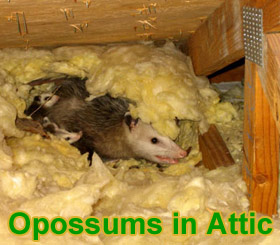 Female opossums
seek out a safe place to have their young, by instinct, so an opossum in an attic is usually a female with young. Luckily with opossums, the young cling to her 24-7, so it's easy to remove them all, without searching for a separate nest of baby animals. Opposums will also
exhibit a unique behavior of denning up in adult groups during the winter. I've seen up to six adult opossums living together in one attic during winter. It's unusual, because possums are not normally social animals. Once opossums get into an attic, they leave a huge mess
with their dog-sized turds, and they also frequently die in attics. The stench has to be smelled to be believed. Read the guide Opossum Mating Habits.
Female opossums
seek out a safe place to have their young, by instinct, so an opossum in an attic is usually a female with young. Luckily with opossums, the young cling to her 24-7, so it's easy to remove them all, without searching for a separate nest of baby animals. Opposums will also
exhibit a unique behavior of denning up in adult groups during the winter. I've seen up to six adult opossums living together in one attic during winter. It's unusual, because possums are not normally social animals. Once opossums get into an attic, they leave a huge mess
with their dog-sized turds, and they also frequently die in attics. The stench has to be smelled to be believed. Read the guide Opossum Mating Habits.
How Do You Get Opossums Out of the Attic? - The best bet is trapping, or removal by hand or snare pole in the attic. Exclusion doors will work too. The best starting point for you is education. Here are tips about possums in the attic:
TYPE & TIME OF NOISE: Opossums are nocturnal. They are pretty slow, and they usually sound like a ...slow, heavy animal walking through the attic. They are actually pretty quiet.
HOW THEY GOT INSIDE: Possums usually just climb up the house and enter an easy opening, like an uncovered soffit vent or open eave gap. They don't really force their way in. But they do need a relatively large opening.
EVIDENCE LEFT BEHIND: A ton of shit, basically! Opossums make huge turds, and lots of them, and they leave them all over the attic. The terds are easy to identify, since they're large with often pointed tips. They also leave the usual trails
in the insulation. The young also frequently fall down walls and scratch and such if that happens. Mostly, people notice the smell of opossums, either living (tolerable odor) or dead (intolerable odor). Click here to see
types of possum damage or read the guide how can opossums damage your attic or shed?.
TIME OF YEAR: Mostly in May and June, as mothers enter an attic to keep their young safe, and again in December & January, to keep warm during the coldest winter months.
METHOD OF CONTROL: Mothballs or ammonia won't make them leave, nor will ultrasonic sound emitters or strobe lights. These tactics have been ruled fraudulent by the FTC, and they DO NOT WORK. Click to learn why
possum repellents don't work. Opossums are easy to trap, either outside OR INSIDE the attic (inside
trapping usually does not work on most critters). If you trap outside, on the roof near the entry point is the best spot. Read my possum trapping tips here. After all the possums are out, including the
young, which are very common in spring and summer, the entry holes have to be sealed.
So in summary, if you want to know how to get rid of possums in
the attic, this is the correct method -
trapping, removal, and sealing of entry points. Not too hard, with possums. Still, it does take experience and knowledge to do it right, so you may want to hire a pro from my list.
Customer Email:
David, I have viewed and read your page about possums. And yes, I have seen a possum in real life.(more than once) Here is my story. On February 14, 2010 at about 5:00 A.M., I was trying to get some sleep minding my own business. I had the light off in my room. Then I heard some weird noise outside my bedroom window. It sounded like my window was about to be open. I was so scared! I thought there was somebody trying to break in.(My room is downstairs by the way.) So I got up and went to my window. I heard scratching at my window and a squeak sound. I checked at the left side of my window, pulling the blinds. I didn't see anything. I still knew something was there, because I heard the noise at the middle part of my window. I checked there. I pulled the blind. Then, I saw something moving. I did't get a clear view, because my window was condensated. I had rubbed the window. Then, I saw it. A possum!!!!!! It was looking at me. The possum was white and had black stripes on the back of it. It had a long pink tail, black nose, and was very huge. It looked like a giant rat. The possum had summoned me. It saw me. Then, the possum
crawled up and into a hole in a vent under
the roof, and into the attic. The possum looked like it was either digging or drinking water
before that. Then I told my mom about it.
I know a little about possums. I know that it's in the animal kingdom and possums are related to skunks and raccoons. Possums just come to our house. And I didn't know that possums can survive in the winter time. I thought they hibernate. Can you give me some more facts about possums? How big can a possum can grow up to? What do they eat? Can possums bite? How fast can possums run? What do possums have to avoid? Please send me back some facts about possums. Thanks!
Thanks for the letter.
Opossums usually don't live more than three years. They can reach up to 15 pounds. They can eat ANYTHING. They can bite, but rarely do,. They can't run very fast. They have to avoid dogs and cars. If it's living in your attic, it can create a lot of damage and a big mess up there,
so perhaps you or your mom should consider having the animal removed professionally.
How to Remove Opossums from the Attic
Need opossum removal in your hometown? We service over 500 USA locations! Click here to hire us in your town and check prices - updated for year 2020.
The attic of a house often presents an inviting shelter for opossums as well as other wandering wild life. This is simply because it is a secure, cool and dark, cozy enclosure with no direct sunlight entering it, and no constant intrusion from humans and predators. All of these factors contribute to make a suitable resting place for the opossum that is similar to its natural habitat. If your attic is comfortable enough, they would only emerge at night to find food before returning there.
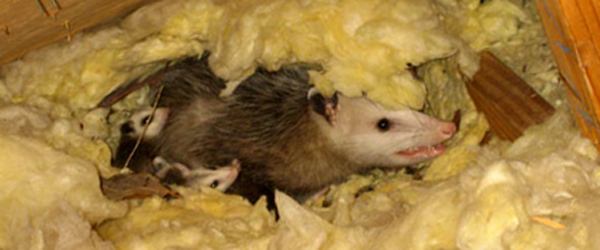
The problems associated with having opossums in your attic include: the noise from their moving around, loads of fecal droppings that stink, associated parasites and disease germs, and the possibility of a sick animal dying inside your attic and becoming an environmental menace.
Getting opossums out of the attic can be achieved easily, when armed with the right knowledge and tools. There are several methods that people use, but the use of live traps and exclusion practices are two of the most effective and humane methods to use.
Live traps
Like in the case of most other wildlife, opossums can be lured into and trapped with live traps. These large, steel cages, measuring at least 32x10x12 in dimension can be purchased from animal control stores; although in different brands but they basically do the same thing – trap opossums.
Bait the trap with food to lure the animal into the cage. Opossums eat almost anything, but the best baits to use in traps include fish, apples, or canned pet food. Foods with strong smells generally work fine as baits. Bait should be smeared evenly on the trap. Place the trap inside the attic or outside it just by their entry point. Read the guide Best Bait to Trap an Opossum.
The chances of catching the troublesome animals are high if all the basic rules are followed. After they’ve been caught, you may transport them far away from your home to release them back into the woods preferably. Or turn them over to the local animal department.
Exclusion door
This is a one-way door that can be placed at the identified exit point of the opossums from your attic; once they go out through it, they would not be able to come back in. Locating this exit point is therefore an important factor in this method.
You must block all of the opossum’s other access points into your attic, except for the one that would have the exclusion door on it. Until you are sure that they’re all out, then seal that up as well.
And if you do not mind getting dirty, you can manually get them out of your attic by using a shovel or a gloved hand to take them out.
Steps to Remove Opossums from the Attic
The majority of pest animals that people will encounter in their attics will be fairly small creatures, but opossums are one of the larger climbing animals that have become a problem for home owners. Opossums are best known for their reaction of playing dead when they are startled, but despite being furry and quite cute, they can cause some significant damage if left unchecked in an attic. There are several signs that you may find that there is an opossum infestation in your attic, and you will also need to consider whether it is just one or if there will be a nest of babies to be removed too. Read the guide How Big Can Opossums Get?
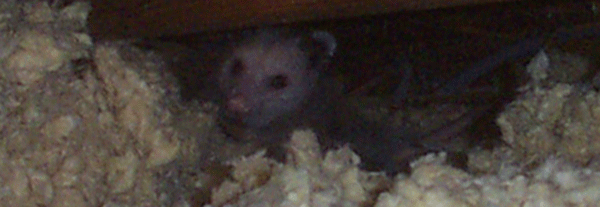
Signs That You Have An Opossum Infestation
The type of noises that you can expect to hear coming from the attic if there is an opossum there will usually sound heavier than smaller rodent species, and will have a more distinct stepping rather than a scampering noise. You may also hear scratching noises coming from the attic, although they do not usually make too many vocal noises. Because they are scavengers in urban areas, you may also see signs that garbage bags have been ripped open, or pet food stores have been raided.
How To Trap An Opossum
A cage trap is the most common way to catch an opossum, and this should be placed in the attic, with a small amount of bait in the trap to draw the animal in. Foods such as apples, fish and pet food are good for this purpose, and leaving a trail of food leading to the trap can actually be successful in catching the opossum.
Relocating An Opossum
Once you have caught the opossum, throw a blanket over the trap itself, as this will help calm the animal, and have a good look around the attic to see if you can find a nest or any signs of baby opossums. When it comes to relocating the animal, make sure you take it at least ten miles away from your property, and look for a rural location where it will not become a nuisance to any other home owners.
Preventing A Similar Opossum Infestation In Future
Once the opossum has been removed, you will need to clear any feces and soiled or damaged insulation, along with identifying any access holes and sealing them to prevent other animals from getting in. If you do have pet food stores or garbage that are easy to access for opossums, it may be worth keeping them sealed or in a shed or garage to stop them from attracting more pest animals to the area around your property. Read the guide Best Ways to Keep Away Opossums and Are Opossums Good Pets?
Go back to the Opossum Removal page.
How to Remove an Opossum from Your Attic
Opossums are mostly peaceful animals, they scavenge in garbage cans and dumpsters for food and they take shelter in woodpiles, sheds, under decks and porches, or in other unexpected places – like the attic. Like some other animals, opossums like the attic because it’s a warm place, it provides shelter and it even provides a food source in some cases. When a possum takes up residence in an attic however, it can cause considerable damage to the structure and should be removed as soon as possible.
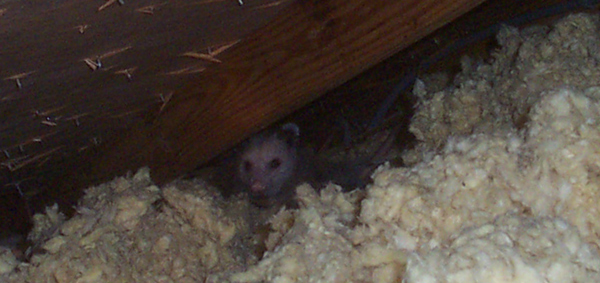
It is common to see female opossums with young nest in attics between May and June, trying to keep their young safe. Again in December & January, opossums have been known to seek the warmth of an attic during the coldest winter months. The first sign you would probably have that an opossum has made a home in your attic is the noise it makes while crawling around in the attic, especially after dusk. Having one in your attic typically means:
- A huge mess with large droppings throughout the attic
- Increased risk of parasites and pathogens spreading through the house
- They tend to die in there and cause a big odor problem
- Baby opossums may fall into the walls and get stuck. And die
- They may chew on and cause damage to ducts and insulation in the attic
- A lot of scratching noise that may disturb your peace
Getting an opossum out of the attic may be a simple or complicated affair. Read the guide how should you kill an opossum?
- Position one or two high-wattage lights in the attic. Bright lights discourage possums and most pest mammals as they prefer to den in dark enclosures.
- Soak a few rags in ammonia, and scatter them in the attic. The noxious odor is likely to discourage the possum from nesting in the attic.
- Bang on the ceiling where you hear the noises. Better still, climb into the attic and make a ruckus with pots and pans, deliberately disturb the peace. Some people go as far as leaving a blaring radio inside the attic to convince the raccoon that it is not a safe place for her young.
- If these deterrents work, the opossum will peacefully exit the attic by itself. Babies are usually carried in the mother’s pouch or clinging to its back at this stage, and this makes it easier to evict them all at once.
- If the deterrents do not chase the opossum away, get into the attic and search for them. Wear protective gloves and grab them.
- You may introduce a live trap in the attic to catch it, but make sure to check it regularly. A better alternative is to set traps outside, on the roof or near the entry hole. You need to check with local game authorities in your area before trapping opossums.
- After the critter has been caught, clean and decontaminate the attic, which will most likely be loaded with large opossum feces.
- Confirm that the opossum has exited the attic, then nail hardware mesh over all cracks and spaces that can lead into your attic or walls. Check on the roof and eaves especially.
If you catch an opossum in your trap, you may relocate it by driving at least 10 miles from your home to release it, preferably in the woods. It might have babies clinging to it, be sure to relocate them all together.
It is also of utmost importance when getting rid of opossums to address the factor that attracted them to your property in the first instance. Without doing this, the problem is only being recycled as the opossum like other scavenging animals, will always go where the food is.
- Keep your yard clean. No eat-out leftovers or litter.
- Don’t leave trashcans and recycling bins outdoors, or if you must, ensure to use animal-proof lids. If possible, keep them indoors or in sealed areas such as a locked shed or outhouse.
- Bring pet food dishes inside at night to avoid attracting wildlife. As long as there is something to eat, they’ll keep visiting.
- Remove or block sources of food and shelter from your property.
- Remove spilled bird seed.
Go back to the Opossum Removal page.


















